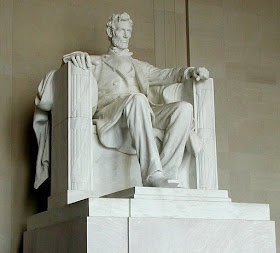 |
| Gravestone of Louisa Maria Wells |
Off along the edge of the cemetery I found this sculpture which serves at the tomb stone for Louisa Maria Wells. The inscription reads, "Out of the fibre of her daily tasks/she wove the fabric of a useful life/Louisa Maria Wells/Died February 20, 1886."
That got me thinking about what kind of useful life she might have had. As it turns out, I'm glad I asked. The story that Wells left behind is interesting--and relatively hidden.
Wells, born in Vermont on October 8, 1815 and died on February 20, 1886, spent most of her life working in the Lowell Mills. From the June 30, 1936 edition of the Lowell Centennial:
This work by Evelyn Longman in the Lowell Cemetery is not only viewed as art for art's sake, an outstanding adornment of the landscape setting in which it is places, but in motive it is peculiarly appropriate to represent the spirit of the men and women who have made Lowell. It motivates the dignity of labor.
The article details what little is known about Miss Wells. Her simple obituary said that "Louisa M. Wells died on Saturday in her home in Varnum Avenue, aged 68 years." She was a farm girl who moved to Lowell for work in the mills.
...The story of the Wells memorial which was first told at the dedication in 1906 and which has since been amplified through research carried on in 1930 by Miss Ethel K. Billings is as affecting as the sculpture itself. A woman worker in the Lowell mills saved from her meagre earnings a dollar or two at a time, and when she died she directed that her savings after funeral and other expenses had been met, should be devoted to building a suitable monument on the lot to which she held title in the Lowell Cemetery. The will was disputed by relatives, but after prolonged litigation it was allowed by the Supreme court to stand. The fund, meantime, had accumulated until it amounted after 20 years to between $7,000 and $8,000.
 |
| Lincoln Memorial |
French, in turn, selected his student Evelyn Beatrice Longman (see here also) to create the sculpture. Women artists had a particularly difficult time getting commissions in this era--French helped her get her start. She went on to a long a rich career creating many objects including the bronze doors of the chapel of the United States Naval Academy in Annapolis; the Spanish War Veterans' monument in Hartford; the bronze doors of the Wellesley College library; the Allison Monument in Des Moines; the Williams Memorial in All Souls Church, New York; the sculptures on the Employers' Liability Building, Boston, and the Statue of "Electricity" atop the Western Union building, New York.
The Lowell Centennial article describes the statue:
Executed in high relief from Tennessee marble within a very simple framing which rises to a height of 15 feet it portrays the peaceful ending of a useful, industrious life Over the relaxed figure of the textile worker looms the beneficent Angel of Death. A single strand of cotton thread which the weaver holds remains unbroken, a symbol of doubtless of immortality.
The ornate sculptures in cemeteries are usually reserved to memorialize the wealthy. They stand as reminders of the power that an individual once held. This sculpture stands alone in its remembrance of an anonymous woman worker who toiled to build the wealth for many of the other families memorialized at the Lowell Cemetery.
I'm glad I met you, Louisa. Your tombstone is a good reminder of the anonymous workers who create the objects that I use in my daily life.
 |
| Lowell Cemetery |
 |
| Ayer Lion, Lowell Cemetery |

wow, what a remarkable thing - thank you for researching this. I love cemeteries for many reasons and often wonder about the stories, hidden.
ReplyDeleteI just love the faint whispers of stories that I hear from time to time in places that I visit. That tombstone certainly had something to say. Maggie walked right up to it and we spent awhile looking at it
Delete